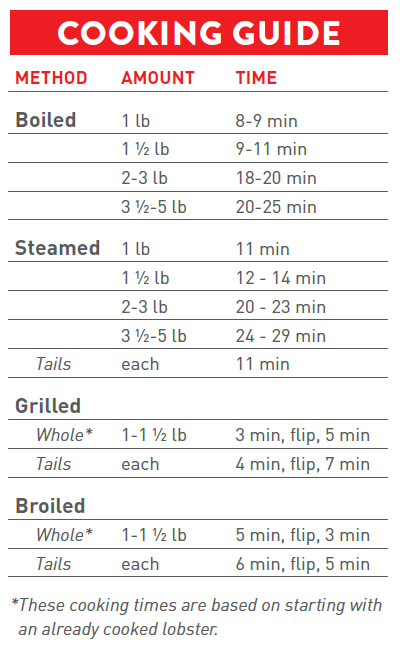Guaranteed fully-meated every time because Clearwater lobster are harvested when energy levels are highest, meat content is maximum and shells are hardest.
Assurance of healthy, strong lobster in peak condition from ocean to plate. As the world leader in stress management, we minimize stress every step of the way to maintain perfect, fresh-caught lobster flavor and quality.
100 percent natural, wild-caught.
Computerized size-grading makes portion control and accurate pricing easy.
Meet increased consumer demand for responsibly harvested, sustainable seafood with Clearwater’s MSC-certified Eastern Offshore Lobster.
Food safety and quality control are ensured through internationally recognized certifications.
Year-round access to fresh, high quality wholesale lobster with Clearwater’s lobster-friendly holding facility.
Exclusive to Clearwater customers, provides a simple, valuable way to increase profits by educating your customers and staff. The program designed by our biologists includes: lobster biology and behavior; tank systems; water temperature and quality; nutritional details; and advice on the care and handling of live lobsters.
Lobster are carefully selected and precisely sized to your needs with our advanced computerized size and quality grading system.
Close to two million pounds of fresh, live lobster are stored in a stress-free environment, modeled after a lobster’s preferred natural habitat. Our lobster-friendly, Dryland Pound Storage consists of an advanced holding system with a pure aquatic environment that is free of chemicals and antibiotics. The lobster’s metabolism is slowed and just-harvested freshness sealed, with health, weight and full-meated texture maintained.

Along with exceptional flavor and quality, Lobster is also recognized as a healthy choice.
| Per 100g Serving | |
|---|---|
| Calories/Energy | 56 kcal/236 kJ |
| Fat | 0g |
| Saturated Fat | 0g |
| Trans Fat | 0g |
| Cholesterol | 80mg |
| Sodium | 510mg |
| Salt | 1.3g |
| Potassium | 230mg |
| Carbohydrate | 0g |
| Dietary Fiber | 0g |
| Sugars | 0g |
| Protein | 13g |
Clearwater Premium Hardshell Fresh Lobster are available in a variety of sizes. We can ship lobsters anywhere in the world, maintaining their fresh, delicious condition. Carefully coldpacked in cushioned compartments ensuring they reach you at the peak of perfection.
Lobster sizing available (approximate weight range noted below)
| Sizing | Weight |
| Chix | 0.93 – 0.95 lbs |
| Small Chix | 0.96 – 1.18 lbs |
| Medium Chix | 1.19 – 1.3 lbs |
| Quarters | 1.4 – 1.5 lbs |
| Halves | 1.6 – 1.7 lbs |
| 1 3/4’s | 1.75 – 1.85 lbs |
| Selects | 1.86 – 2.5 lbs |
| Small Jumbos | 2.6 – 3.1 lbs |
| 3 lb | 3.1 – 3.6 lbs |
| 4 lb | 3.7 – 4.85 lbs |
| 5 lb | 4.86 – 5.85 lbs |
| 6 lb | 5.86 – 6.85 lbs |
| 7-9 lb | 6.86 – 9 lbs |
| 9+ lb | 9+ lbs |
Learn more about our sustainable harvesting practices.
Cooking Guide:
Ideally you should use a meat thermometer inserted into the center of the thickest portion of the body by piercing the thermometer tip through the membrane on the back between the body and tail of the lobster. A properly cooked lobster should reach 80°C (180°F).

Traditional Boiled Cooking Method:
In a large pot, bring 2 litres (½ gallon) of water per pound of lobster to a boil. The maximum water level should not exceed half of the pot to account for the lobster and boiling water. Add ½ cup of sea salt/kosher salt per 4 litres or 1 gallon of water. Carefully add lobsters headfirst into the water. Cover. When the water returns to a boil, set a timer according to the Cooking Guide provided. To avoid overcooking, only similarly sized lobsters should be cooked together. If there are various sizes in the pot, base the cooking time on the largest lobster to ensure that it is cooked.
Steamed Cooking Method:
Pour 2 inches (5 cm) of water in a large, heavy bottom pot and lace a steam rack into the pot. Bring the water to a rolling boil and carefully add the lobsters on top of the rack, one at a time. Cover with a lid and set a timer according to the Cooking Guide. Check the water after five minutes to ensure there is enough in the pot so it does not burn dry. Take care when removing the lid as there will be a lot of hot steam inside. Remember to open the lid away from you. Steamed lobsters may require more time, but the gentle cooking method will yield a more tender and juicy lobster with less chance of overcooking.
Broiled Cooking Method:
*This method uses a 1 ½ lb pre-cooked lobster after chilling.
Split a cooked lobster in half lengthwise. Remove and discard the vein running down the tail and the small sac located behind the eyes. Crack the claws with a lobster cracker or the back of a knife. Brush the lobster with melted butter or basting sauce to keep the meat moist and tender. Place on a broiler pan and broil, shell side up, for 5 minutes, then flip and baste with butter and broil for another 3 minutes, or just until the lobster is heated through. Be careful not to overcook.
Grilled Cooking Method:
*This method uses a 1 ½ lb pre-cooked lobster after chilling.
Split a cooked lobster in half lengthwise. Remove and discard the vein running down the tail and the small sac located behind the eyes. Crack the claws with a lobster cracker or the back of a knife. Brush the lobster with melted butter or basting sauce to keep the meat moist and tender. Place directly on the grill, meat side down, for 3 minutes, then flip and baste with butter. Cover the lobster with a metal bowl or close the lid on the grill and cook for another 5 minutes, or just until the lobster is heated through. Be careful not to overcook.
Re-heating
To re-heat cooked lobster, simply steam in 1 inch of boiling water in a heavy bottom, covered pot for 3 minutes for a 1 ¼ pound lobster (increase time by 30 seconds per pound over 1 ¼ pounds). To re-heat by boiling method, place lobster into boiling water for 3 minutes for a 1 ¼ pound lobster (increase time by 30 seconds per pound over 1 ¼ pounds).
How do you know if your lobster is undercooked?
If your lobster is undercooked the meat may appear opaque (not white) and a thick translucent liquid may be found inside. If it is a female, there may be a black, oily gel inside the body and tail. This is undercooked roe (eggs). Externally, the shell may not yet be entirely red.
What to do if your lobster is undercooked?
An undercooked lobster should be returned to the boiling pot or steamer to cook until it reaches an internal body temperature of 82°C (180°F). Cooking times may vary by size of lobster, with larger lobsters subject to longer cooking times. When fully cooked, the meat will appear white and the shell will be red. If it is a female, the roe (eggs) will also be bright red in colour.
How do I handle live lobster?
Live lobster should always be handled with care. Pick the lobster up by its body, being sure to avoid contact with the claws. If you put force on the claws, the lobster may release them as an escape response. Also, a lobster can close their crusher claws with a force ranging from 27 to 58 pounds. Elastic bands are usually kept on the claws to prevent accidents.
How do I store live lobster?
Lobster should always be kept wet and cold in your refrigerator until cooking time. Do not submerge lobster in fresh water or ice; simply place them in a large open container in your refrigerator and cover them with a damp cloth/paper towel.
How many days can I keep live lobster?
If lobster is kept cool and damp in the refrigerator and you have followed proper storage instructions, they can typically be kept for a maximum of two days (including transit time).
How long can I keep cooked lobster?
Cooked lobster in the shell can be kept for up to two days in your refrigerator in a covered container. Cooked lobster meat shucked from the shell can be refrigerated for two to three days in a covered container.
Can live lobster be frozen?
Live lobster should not be frozen; however, cooked and shucked meat and cooked, shell-on lobster can be properly frozen quite easily. Cooked lobster meat (shucked or shell-on) can be frozen while submerged in a prepared brine solution in a container or freezer bag (¼ cup salt with 1 liter of fresh water).
How do I defrost frozen lobster?
Frozen lobster can be defrosted in your refrigerator for 15-18 hours (recommended method) or by placing it in a sealed plastic bag under cold running water for quick defrost.
What is the best way to cook lobster?
Traditionally, lobsters are prepared by immersing them in a pot of salted water heated to a rolling boil. This cooking method offers the advantage of retaining the delicate texture and flavor of the product.
Why do lobsters turn red when cooked?
A lobster’s shell is naturally red in color, which is caused by a carotenoid pigment, similar to that which is found in carrots. Other pigments on the surface of the shell mask the underlying red color. Cooking destroys the surface pigment’s protein bonds, allowing the underlying carotenoid pigment of the shell to show through. The lobster then turns its natural color, which is red. The change in color usually occurs rapidly since the pigment bonds begin to break down as soon as the lobster is immersed in boiling water.
What is the green substance found inside a cooked lobster?
This is called the tomalley and it functions similarly to the liver and pancreas in the lobster. The tomalley is edible and some people consider it to be a delicacy since it is very high in flavorful lipids.
What is the red/coral substance found along the inside of the lobster tail?
This is called lobster roe or eggs and is only present in females. Lobster roe is edible and some people consider it to be a delicacy. Uncooked lobster roe is dark green, only turning red when cooked, just like the shell.
What causes some lobsters to be blue?
Blue lobsters are caused by genetic differences in the pigments that make up the shell surface color. Rather than containing all of the pigments that combine to make a green-brown color, the shell of a blue lobster contains only a blue pigment. Genetic differences can also cause other strange colorings, such as light orange and patterns including yellow spots.
What is the black oily substance?
Your lobster is undercooked if you find a black, oily gel inside the body and tail. This is a result of the roe (eggs) being undercooked.
What to do if your lobster is undercooked?
An undercooked lobster should be returned to the boiling pot or steamer to cook until it reaches an internal body temperature of 82°C (180°F). Cooking times may vary by size of lobster, with larger lobsters subject to longer cooking times. When fully cooked, the meat will appear white and the shell will be red. If it is a female, the roe (eggs) will also be bright red in colour.
To serve our customers better, our website content has been customized for different customer types based on their needs and interests. Have a suggestion on how we can serve you better, please let us know.
